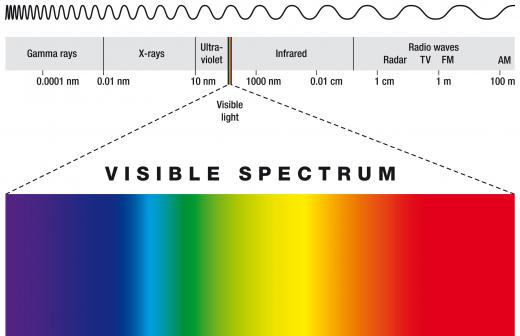What Is Continuous Spectrum?
A continuous spectrum is a spectrum that shows no interruptions across its entire range. A rainbow is a good example of a continuous spectrum. By passing white light through a prism, Sir Isaac Newton was the first to show that it was made up of a continuous spectrum of all the wavelengths of visible light. Spectra are important in the study of astronomy, and a continuous spectrum can any unbroken segment of the entire electromagnetic spectrum, whether visible or not.
All electromagnetic energy can be at least partially defined by its wavelength. The portion of the entire electromagnetic spectrum that is visible to human eyesight is perceived by us as light and is called visible light. Humans can see light that ranges from violet to red. Violet light has the shortest wavelength of all visible light and red has the longest. Since we can see all the different wavelengths of light along this portion of the electromagnetic spectrum, we perceive it as a continuous spectrum.

Astronomers often use spectra to study stars and other astronomical bodies. Spectra are the segments of the measurable electromagnetic energies emitted by these objects. By studying the spectra of stars, astronomers can learn a great deal about them, including their elemental make-up, as different elements emit light of a certain wavelength when highly energized, such as happens in the intense heat within a star. Gaps in continuous spectra, known as absorption lines, show where an object either does not emit light at the wavelengths where the gaps occur or that it absorbs light at these wavelengths. Similarly, emission lines are lines in spectra that show an increase in the energy emitted at certain wavelengths, showing as distinct lines that are brighter than the surrounding spectrum.

Other kinds of spectra besides light may be said to be continuous. Any segment of the entire electromagnetic spectrum that, taken as a section, shows no gaps along its range is said to be a continuous spectrum. Also of great use to astronomers and astrophysicists, electromagnetic energies like radio waves and microwaves are also part of the spectra of energy emitted by many astronomical bodies. By studying these spectra and any absorption lines or emission lines, scientists are able to learn a great deal about them, the way they interact with each other, and the universe as a whole.
AS FEATURED ON:
AS FEATURED ON:













Discussion Comments
I would be curious if the aurora borealis wouild be considered to be a continuous spectrum light? When viewing them--especially in Northern Alaska--the colors whip around and into each other making for an interesting blend of colors. While seemingly continuous, you can also see them dissolve a bit, making a hole in the color, then whip back into a bright green or red. Such a beautiful sight!
Post your comments